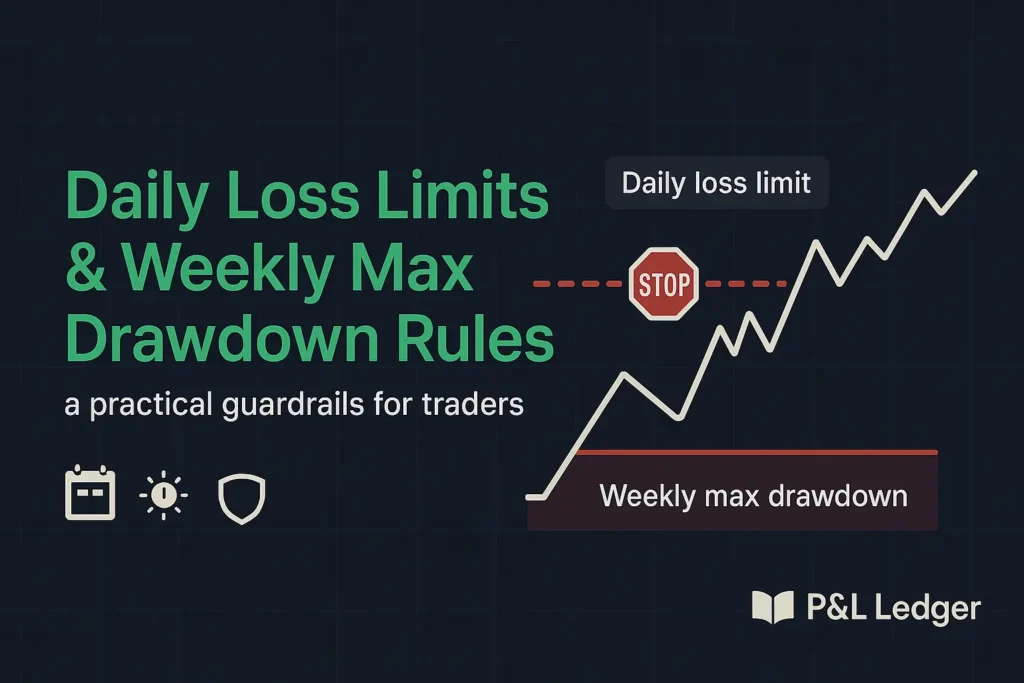What these rules are and why they matter
A daily loss limit is a hard stop on how much you allow yourself to lose in a single session. A weekly max drawdown rule is the same idea stretched across five trading days: if your equity falls by that amount from the week’s starting balance or peak, you stop trading and review. These are not about being timid, they are about survival. Maximum drawdown – your worst peak-to-trough drop, captures the damage losing streaks can do to both capital and confidence, and it’s far easier to prevent a deep hole than to climb out of one.
Traders and coaches who study performance emphasize that keeping bet sizes reasonable and limiting drawdowns preserves the psychological bandwidth needed to execute. If you hit a limit, you quit for the period, because discipline erodes quickly after frustration spikes. The rule breaks the spiral before it starts and protects you from the day the market’s tempo doesn’t match your playbook.
Choosing numbers you can actually live with
There isn’t a single correct limit, but there are sensible anchors. Start with how much you risk per trade. Try to start with the 1-2%-of-equity rule and work backward to a daily cap that makes a run of losses survivable without forcing you to size down to irrelevance. If you risk 0.5–1.0% per trade, a daily limit of 1.5–3.0% generally means three losing trades or so and you’re done for the day.
For portfolio-level protection, Alexander Elder popularized a 6% monthly drawdown stop. Many traders adapt this logic to a weekly cap in the 2-3% range so that a bad week doesn’t cascade into a bad month. None of these numbers are commandments, they are starting points to test against your own distribution of R-results and volatility. The aim is simple: you want limits that let you survive a realistic losing streak while leaving enough risk budget to express your edge when conditions return.
Wiring the limits into your workflow so they’re real
A rule only works if it triggers automatically. Prop-style accounts enforce daily loss limits with auto-liquidation and a lockout until the next session. You can mimic that structure by using platform alerts or broker risk controls that cuts positions when your loss tally crosses a threshold. Define what “day” and “week” mean for your product’s session times, then set a daily cap and a weekly cap that reset on a fixed schedule. If you hit the daily stop, flatten and log the day, no exceptions. If you hit the weekly stop, stand down and run a review before you trade again.
Consider tagging your journal with “limit hit” to study what typically precedes those days – late entries, wider spreads, news impulses, or drift after an early miss. The goal isn’t to punish yourself, it’s to create a circuit breaker that lets you protect capital and data quality so your statistics remain trustworthy.
Sticking to the limits when emotions run hot
The biggest challenge is not mathematical, it’s psychological. After a couple of losses, the impulse to get it back surges, and that’s precisely when rules save you. Coaches who work with active traders point out that limiting drawdowns up front and keeping position sizes modest prevents the cognitive narrowing that leads to revenge trades.
Build friction around breaking rules. A physical checklist before each order, a five-minute timer after any loss, and a prewritten end-of-day script that you trigger the moment the cap is touched. Pair that with a process mindset – you’re not ending the day as a failure, you’re preserving the ability to fight tomorrow with a clear head. If you want extra reinforcement, add a profit-lock rule for the day as well. It’s easier to honor loss limits when you also protect green days from turning red through overtrading. These small habits keep discipline intact when screens are yelling.
Reviewing and adjusting without moving the goalposts
Limits shouldn’t drift with mood, they should evolve with data. Once a week, audit your trades in R-terms and compare realized volatility and average drawdowns to your limits. If your daily equity swings have shrunk because you tightened risk per trade, consider nudging the cap down to maintain the same number of chances per day. If you’ve scaled up or added a faster setup, confirm the cap still covers a typical string of losers without wiping out a week’s progress. Keep in mind that costs and slippage make the functional limit tighter than the headline number, particularly for high-frequency entries.
If you want an external benchmark, you can try capping daily loss before it threatens the larger drawdown guardrails. Combine that with the 1-2% risk-per-trade framework and Elder’s portfolio stop to shape rules that fit your pace and products. The consistent execution of these guardrails, not their perfection is what keeps you in the game long enough for your edge to show.
Daily & weekly loss limits calculator
Here’s the free Excel Daily & Weekly Loss Limits calculator we use. Plug in your account size, your risk per trade (%), and how many trades you plan to take in a session, and it instantly computes your per-trade risk in currency, plus two guardrails for each timeframe, a percent-of-equity cap and an R-multiple cap – then recommends a conservative suggested daily loss limit and suggested weekly max drawdown by taking the lower of the two. The defaults reflect widely taught anchors (risk ~1-2% per trade, daily caps to prevent “give-back,” and Elder’s 6% monthly stop adapted to a weekly horizon), and the structure mirrors how many prop venues enforce daily loss limits with hard lockouts, so you can bring that same discipline to a personal account.
